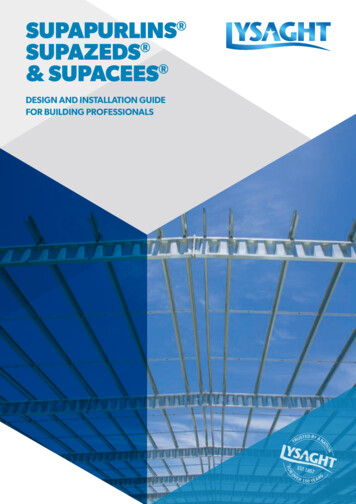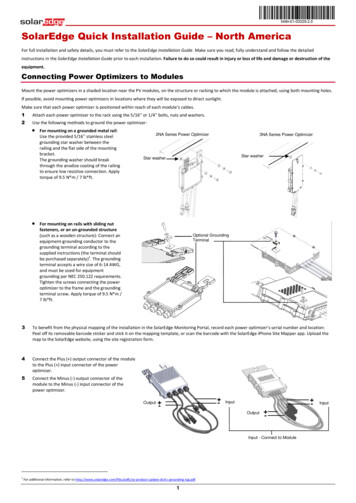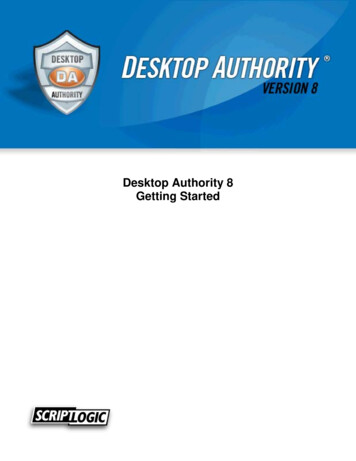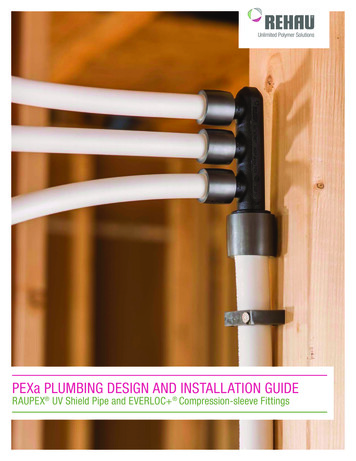
Transcription
SUPAPURLINS SUPAZEDS & SUPACEES DESIGN AND INSTALLATION GUIDEFOR BUILDING PROFESSIONALS
ContentsSECTION 11.0Introduction56SECTION 22.0 Product Range2.1SUPAPURLIN Product Range92.2Purlin Product Coding92.3Standard Purlin Product Range92.4Non-Standard purlin options92.5Material Specification102.6Holing Of Purlins102.7Accessories132.8HOOK-LOK II Bridging Members152.9LYSAGHT Series 300/350 Bridging System182.10Procurement182.11Sample Order Forms19SECTION 33.0 Assemblies & Installation4.1Design Notes To Limit State Capacity Tables304.2Index To Limit State Capacity Tables314.3Capacity Tables32Single Spans322 Span Continuous422 Span Lapped524 Span Lapped62Capacity Tables - Other Design Effects82Design Optimisation82Stepped Loading82Point Loads83Axial Loads84Specification Statement844.4SECTION 55.0 Purlins & Girts - Design Matters5.1Purlin Orientation865.2SUPAZED Wide/Narrow Flange Orientation875.3Bridging Design885.4Other Design Matters933.1Purlin Connections233.2Typical Assemblies With Trimming Brackets243.3Roofing & Walling Assemblies253.4Bridging Assemblies26SECTION 66.0 Engineering Data On Purlin & Girt Profiles3.5Bridging Installation276.1Design Principles6.2Traditional Zeds & Cees6.3LYSAGHT SUPAZEDS & SUPACEES97 98 99SUPAPURLINS SUPAZEDS & SUPACEES Preface, Scope & WarrantyPurlins: Features, Applications & Benefits31.11.2SECTION 44.0 Purlin & Girt Limit State Capacity Tables
SECTION 11.0 IntroductionSUPAPURLINS SUPAZEDS & SUPACEES 4
1.1 PREFACE, SCOPE & WARRANTYWARRANTYPREFACELysaght has always had the most comprehensive product warrantieson the market that cover not only the corrosion performance ofthe material but also the structural and serviceability performanceof a wide range of products. Lysaght can back their products withover 150 years experience and credibility. The Lysaght brand iswidely recognised as setting the benchmark on quality products,and is trusted and respected by our customers and competitorsnationwide.Cold-formed steel purlins and girts have been used in Australia formany years. During that time, technology has improved with thedesign of these sections in accordance with the Australian StandardAS/NZS 4600 Cold-formed steel structures code. Howeveruntil recently there has been no major step forward in the actualdevelopment of the profile from the traditional Zed or Cee.Since 1987, Lysaght in conjunction with the University of Sydney,has been intensively researching the behaviour of purlin andgirt systems utilising the “state of the art” vacuum test rig at theuniversity. The results obtained from this research has beenused to develop the design rules for AS/NZS 4600. Fromthis research Lysaght committed itself to further research intoperformance improvements of the purlin profile. This has lead to thedevelopment of the LYSAGHT SUPAZED and SUPACEE profile.These profiles released early 2000’s are aimed to attain highercapacities without affecting the current industry practices of designdetailing and installation.This tradition of warranty protection is now available on thenew range of LYSAGHT SUPAPURLIN profiles. This warrantycompliments the warranties available for the LYSAGHT roof andwall cladding profiles that are commonly fixed to the purlins.Application for a SUPAPURLIN warranty must be lodged on our‘LYSAGHT SUPAZED & SUPACEE Request For Warranty’ form,available by contacting the nearest Lysaght Service Centre. Thewarranty is available subject to application and project size.Additional warranty periods with additional coating treatments areavailable subject to enquiry.The SUPAZED and SUPACEE profiles are patented and jointlyowned by Lysaght and Sydney University.SCOPEThis publication has been prepared with a view of providingdesigners, specifiers, fabricators, builders and erectors the relevantdata to enable easy selection, specification and detailing of a roofor wall system using the new SUPAPURLIN profile range.The information contained herein includes: Product features, applications and benefits Product ordering Product handling Product detailing, installation and assembly New format of capacity tables, and an even larger range ofconfigurations. More advanced information on design issues including SteppedLoading. More detailed information on design, construction andinstallation issues including profile orientation, bridging, packers,suspended services. Product dimensional data and section properties.The standard range of purlin products available is: Traditional Zeds & Cees purlin profiles for 100 deep sections(offer varies by region. Contact your local sales office for productavailability).5These purlin products are available with a wide range of accessoriesand bridging systems for the full range of purlin profiles.SUPAPURLINS SUPAZEDS & SUPACEES SUPAZED and SUPACEE purlin profiles for 150, 200, 250,300 and 350 sections (plus 400 in Queensland and SA only).
1.2 PURLINS: FEATURES, APPLICATIONS& BENEFITSTRADITIONAL ZED AND CEE SHAPES FEATURES Single webTERMINOLOGY T op & Bottom flange. The Cee profile has equal flanges. TheZed profile has the flanges facing in opposite direction andone flange is “wide” and one is “narrow” to allow lapping (Ceeprofiles cannot be lapped).In the building industry the terms “purlin’ and “girt” apply to thestructural member that spans between frames onto which claddingis attached. When the member is used in the roof is called aPURLIN, and when used in the wall it is called a GIRT.Bridging (2 rows)CeeBridging (1 row)nEnlnaer nInt nghgtenandBuilalneranpdSanBuilding heightWide flangeLippdSPurlinspacingZedFlangepadSrlin Lip stiffeners at the free end, or extremity, of the flange. Theselips point back towards the centre of the profile.ildBuWebWebanLipSpNarrow flangeThe purlin span horizontally and at right angles to, and spanningacross, rafter supports or roof truss supports. The roof cladding isfixed to the outside or top face.The girt span horizontally and at right angles to, and spanningacross, column supports. The cladding is fixed to the outside face.The purlins and girts are traditionally fixed to the fabricated steelframe supports by the use of cleats.Bridging are stiffening members between the purlins/girts tolimit the lateral and rotational movement of the purlins/girts. Thismovement is a form of buckling, and limitation of this buckling candramatically increase the load carrying ability.APPLICATIONSLYSAGHT purlins and girts are commonly used in commercial,industrial and rural buildings, however they are also popular inmedium and small structures such as sheds and awnings.Although the LYSAGHT purlins and girts sections have beendesigned for this specific application, due to their versatile shapethere is a vast range of other applications where these sectionsare equally useful and commonly used. Some of these otherapplications are: Structural frame of small and medium sized buildings Racking frames Wall framing such as stud and plate/track Floor joists Rafters and beamsSUPAPURLINS SUPAZEDS & SUPACEES PostsTRADITIONAL PURLIN SHAPESThe traditional purlin profiles (shapes) are the traditional Zed andCee (or channel). These are the most versatile and economicsections to use for purlin and girt applications.Each of these shapes has benefits that complement each otherwhich satisfy most building needs.CEE PROFILE BENEFITS The lip stiffener provides significant increased strengthcompared to no lip stiffener. More aesthetic for uses in exposed applications such as carportsand awnings. The shape is closed similar to the traditionalboxed, tubular or solid shapes. Certain detailing is simpler with Cee sections, such as fascia/eaves purlins for gutter installation, edges of roofs, back-to-backor lip-to-lip (“I” or “box”) construction. Stability during construction is a benefit in some applicationssuch as flooring.ZED PROFILE BENEFITS The lip stiffener provides significant increased strengthcompared to no lip stiffener. Lapping ability results in greater performance (strength anddeflection) and economic design. Continuity and doublethickness material at the required location (at support regions)results in greater performance available when used in multi-spanconfigurations. Thus there are considerable economic benefitsto be made. Variable thickness can also be designed in each bayto enable even greater economies. The nesting ability of Zeds results in considerable reducedvolumes. Reduced volume of bundles result in lowertransportation costs, lower handling costs and reduced handlingtimes.6
OTHER PURLIN SHAPESSUPAPURLIN SHAPESThe SUPAPURLIN profiles consist of a SUPAZED and SUPACEEprofile. These SUPAPURLIN are an advancement of the traditionalZed and Cee profiles. The benefits of the traditional Zed and Ceeprofiles are retained, however there are substantial added benefitsof the new SUPAZED and SUPACEE purlin profiles. The features of the traditional purlins that are the same in theSUPAPURLIN shapes are: Single web. Top & Bottom flange. The Cee profile has equal flanges. TheZed profile has the flanges facing in opposite direction and oneflange is “wide” and one is “narrow” to allow lapping. Lip stiffeners at the free end, or extremity, of the flange. Theselips point back towards the centre of the profile.ADDITIONAL FEATURES OF THE SUPAPURLIN SHAPES Longitudinal web stiffeners (4 off). Lip has an added stiffener at the free end, or extremity, of thelip. These added stiffeners point back towards the centre of theprofile.Downturned lip purlins are available in Queensland and SouthAustralia only.There are other steel shapes manufactured by Lysaght that are usedfor purlins and girts: Boxed sections such as LYSAGHT FIRMLOK Beams. Theseare commonly used in the Home Improvement Market such ascarports and awnings where a more architectural or aestheticeffect is required. Fixing methods are with simple brackets andscrew fixing.Refer to our LYSAGHT FIRMLOK Beams publication "Top hat” type sections such as LYSAGHT TOPSPAN 120.These are commonly used in applications where the ease ofinstallation is more important than economic profile. Theseprofiles are used where the loads are lighter and spans areshorter. Fixing methods are simple screw fixing and there is nobridging installation.Refer to our LYSAGHT TOPSPAN series publications.LYSAGHT FIRMLOK beamLip stiffenersLongitudinal webstiffenersTopspanLYSAGHT TOPSPAN 120Thus the benefits of the traditional Zeds and Cees are retainedand there are a number of added benefits with the SUPAPURLIN profiles. These added features result in the following addedbenefits: No change to the accepted practices of packaging, marking andhandling. No change to the accepted traditional practices of installation.The lapping method is unchanged, the cleat fixing isunchanged, the bridging installation is unchanged, the fixing offly bracing and accessories is unchanged. There are added benefits to handling and installation; Minimal face-to-face metal contact minimised staining ofsurfaces, and no locking of purlins in frozen bundles. Purlin nesting results in no wedging/interlocking of purlins inbundles ease of separation on site. Rigidity of purlin added safety and less labour requirementsduring the flipping of purlins during installation onto cleats. Unique patented profile, which cannot be copied. What isspecified is what you get. Thus the design strength is notcompromised and the material is guaranteed to be Australian. Significant improvement in strength performance can beachieved in many purlin sizes and span configurations. Thusthere are considerable further economic benefits to be made.7 Rounded corners added site safety due to ease of sliding ofpurlins on rafter surfaces, and no damage to surfaces of paintedrafters from sliding of purlins during installation.SUPAPURLINS SUPAZEDS & SUPACEES Rounded lips added site safety from handling of sharp edges.
SECTION 22.0 Product RangePURLINS, ACCESSORIES, BRIDGING & PROCUREMENTSUPAPURLINS SUPAZEDS & SUPACEES 8
2.1 SUPAPURLIN PRODUCT RANGE (NSW, QLD, SA)ProductDepth (mm)Thickness (mm)Bolt RequirmentsPurlin Shape and NameBridging SystemZ/C100101021.0M12 Grade 4.6 or 8.8Traditional Zeds & CeesLYSAGHT HOOK-LOK II BridgingSystem with Clamp/locator ends orbolted bracket 1.0 20024SZ/SC250152.4300SZ/SC300241.9M16 Grade 4.6 or 8.8LYSAGHT Series 300-350 SC40024**1.51.9SZ/SC25024SZ/SC35024*SUPACEE 2.4254SZ/SC25019SZ/SC30019SUPAZED 3.0SZ/SC40030**3.0SZ/SC40032**3.2Details on application1. Purlins marked * availability is subject to enquiry. Consult your local Lysaght Service Centre for advice. Extended lead times may apply.2. Purlins marked ** are available in QLD and SA only. Consult your local Lysaght Service Centre for advice. Extended lead times may apply.3. Queensland and South Australia are able to manufacture downturned lipped purlins. Available subject to enquiry. Consult your local Lysaght Service Centre for advice. Extended leadtimes may apply.4. Purlins marked s are subject to enquiry. Consult your local Lysaght Service Centre for advice.2.2 PURLIN PRODUCT CODING2.3 STANDARD PURLIN PRODUCT RANGEThe coding of the purlin products consists of prefix letters followedby a series of numbers.The standard range of purlin products and the associated bolts andbridging system to use are detailed above.The prefix letters are for the various purlin shapes and consists of:2.4 NON-STANDARD PURLIN OPTIONSSZ for the LYSAGHT SUPAZED shapeSC for the LYSAGHT SUPACEE shapeThe letter prefix is then followed by a three digit number indicatingthe section nominal depth in millimetres (not the actual depth).Thus the nominal depths would be 100, 150, 200, 250, 300, 350or 400.This is then followed by a two digit number designating sectionthickness. This would be “10” for 1.0mm BMT, up to “32” for3.2mm BMT.For example SZ20012 designates a LYSAGHT SUPAZED 200millimetres nominal depth and 1.2 BMT.Where reference is made to both purlin shapes of the same sizethen designation such as SZ/SC is used, similarly for other shapes.Non-Standard purlin options are available subject to enquiry. Thesenon-standard options are available on special projects only and willbe subject to minimum order quantities and extended lead times.The non-standard purlin options include: variation of material specifications variation of profile dimensions variation of material thicknessThese options could be considered to tailor a profile specifically forproject needs.For special projects please contact your local Lysaght ServiceCentre and provide all the relevant project details and designinformation.SUPAPURLINS SUPAZEDS & SUPACEES C for the LYSAGHT traditional Cee shape9Z for the LYSAGHT traditional Zed shape
2.5 MATERIAL SPECIFICATIONSTANDARD HOLES FOR ZED AND SUPAZED SECTIONSLYSAGHT purlin sections are roll-formed from GALVASPAN steelcomplying with AS 1397-2001, in the grades shown. The numberprefixed with Z indicates the minimum coating mass in g/m2.Lapped ConnectionBMT (mm)GradeCoating 2.4G450Z3503.0G450Z3503.2G450Z350SpanLapSpanEnd BayOverhang varies* Coatings for C10010/Z10010 may vary from centre to centre. Contact your local LysaghtService Centre for advice.2.6 HOLING OF PURLINSGENERALLYSAGHT purlin profiles can be supplied punched or unpunched.Where holes are required, these are done to industry standards atcleats supports (where the purlin is bolted through the web to thecleat at end supports and internal supports), at ends of laps and atbridging points.Non-standard holing may be available subject to enquiry.Negotiation for special projects will be subject to minimum orderquantities and extended lead time. This non-standard holing canconsist of no holes (un-punched) or some limited variation of: Hole sizeSpanSimple ConnectionLengthSTANDARD HOLES FOR CEE AND SUPACEE SECTIONSSimple ConnectionSpan Hole location Hole quantity Hole patternLengthSTANDARD HOLE SIZEThe purlin hole sizes are in accordance with the requirements ofAustralian Standard AS/NZS 4600 Cold Formed Steel Structures.For the purlin sizes in the nominal range 100 to 250, the holesare elongated with dimensions of 18mm x 22mm suitable forLYSAGHT M12 Purlin Bolts. The long dimension of 22mm ismeasured in the direction of the purlin length.2218Overhang VariesSpanEnd bayBRIDGING HOLES AND CLEAT HOLESGauge lines (G)22Not drawn to scale.For the larger purlins sizes of nominal depths of 300, 350 and 400,the holes are 22mm diameter suitable for LYSAGHT M16 PurlinBolts.Holes for bridging & cleatsSTANDARD HOLE PATTERNS & LOCATIONSSUPAPURLINS SUPAZEDS & SUPACEES 35 min.There are two standard punching patterns available and thelocations along the length of the purlin will depend upon thepurpose of the holes. The patterns/location of the holes are; Two (2) holes in the web located at the gauge lines. This is forfixing of the purlin at cleats and for installation of bridging. Two (2) holes in the web located at the gauge lines, and two (2)holes in the flanges (one hole per flange). This is largely for fixingat ends of laps, however this is also the standard hole punchingat the ends of all purlins. The minimum edge distance of theholes (add centres) from the ends of purlins is 35mm as shownin diagram at right.CLGauge line (G)Note: Web stiffeners do not interfere with bolt length, lapped capacities or fitting of lapswhen SUPAZED purlins are used on a lapped configuration.10
STANDARD HOLE GAUGE LINESThe holes punched in the webs are located at the acceptedindustry standard gauge lines. The gauge lines are as detailedbelow and the holes are equally spaced above and below thecentreline of the purlin.Purlin Nominal SizeGauge Line (G) 210SZ/SC350260SZ/SC400310SINGLE SPANSOne row of bridging0.50.50.50.50.50.50.50.50.50.50.50.5Two row of 280.220.220.28END SPANS (CONTINUOUS)One row of 0.330.280.390.330.280.390.33Two row of e row of 0.27bridging0.27110.280.280.28SUPAPURLINS SUPAZEDS & SUPACEES Three row of bridging
dSpans(lapped)OnerowofbridgingOne row of bridgingOne row of bridgingOne row of idgingbridgingTworowsbridgingTwoTwo rows of hree rowsrows ofof 7InteriorInterior SpansSpans (lapped(lapped andand unlapped)unlapped)INTERIORSPANS(LAPPED AND UNLAPPED)One row 0.500.50TworowrowsbridgingTwoof ofbridgingTwo rowsofbridgingTwo rows of ingThree 0.220.280.28SUPAPURLINS SUPAZEDS & SUPACEES 12
2.7 ACCESSORIES3) ANGLE CONNECTORSThere is a range of LYSAGHT accessories available for use withthe LYSAGHT purlins. These accessories are an integral part of theLYSAGHT purlin and girt system. All LYSAGHT accessories arecoated steel.The angle connectors are detailed to allow connections of sectionsof the same size or one size smaller.Angle connectors90 mm for Product Code 100AAC140 mm for Product Code150AAC7070Product Code100AAC150AAC251) PURLIN BOLTSBolts with integral washers in both the head and nut shall be usedfor all types of connections described in this manual as required byAS/NZS 4600, Clause 5.3.1.1907070M12 SIZEPB1230 LYSAGHT standard purlin bolt (grade 4.6): M12x30mmwith nut.PB1230HS LYSAGHT high-strength purlin bolt (grade 8.8):M12x30mm with nut.Product Code200AAC1535403535M16 SIZEPB1645 LYSAGHT standard purlin bolt (grade 4.6): M16x45mmwith nut.PURLIN TRIMMING BRACKETSA variety of brackets are available for trimming around wall and roofpenetrations such as doors, windows and services. These bracketsare for lightly loaded applications, not for highly loaded structuralconnections.2) GENERAL PURPOSE BRACKETS70Product Code250AAC7050184) CLAMP PLATES6 holes18mm diameterG24070Used in conjunction with angle connectors and racking girt bracketto allow connections to the hips of Cee and SUPACEE purlins.54HI25L75Product Code100CPK35J(Also available in 150CP, 200CPand 250CP in QLD.)1835BRACKET 2016020367327BA907525Product ories for larger purlin range are subject to enquiry.(Also available in 100CP in QLD.)SUPAPURLINS SUPAZEDS & SUPACEES G(mm)13BracketProductCode
5) RAKING GIRT BRACKETProduct Code C100RBThe Raking Girt Bracket is used to attach the ends of the C10015Raking Girts to the Fascia. Bracket is supplied formed at rightangles, as shown, and is formed on-site by the erector to thecorrect angle to suit to roof slope.9018540 25704025135186) RAKING GIRTThe raking girt is simply a C10015 purlin profile. The raking girtbracket has been dimensioned to suit this girt.13.5511027) OTHER ACCESSORIESThere are other accessories that may be available subject toenquiry, and these may be subject to minimum order quantities andextended lead times.These other accessories may include: Purlin bolts (different sizes and grades)SUPAPURLINS SUPAZEDS & SUPACEES Flange fixing washers Plate cleat and angle cleats. When angle cleats are used theprojecting leg may require cropping to avoid interference withpurlin lip Purlin profiles specifically shaped for fascia application Purlin profiles with down-turned bottom lip14
2.8 HOOK-LOK II BRIDGING MEMBERSPRODUCT CODESThe HOOK-LOK Bridging system is the standard and most widelyused bridging system available and is suitable for most projects. Itis fast and easy to install and can accommodate most constructionconfigurations.The product codes for HOOK-LOK II bridging members indicatethe purlin size for each end (nominal depth), type of end and typeof channel/turnbuckle that the ends are fixed.This system is suitable for purlin sizes from 100 to 250.EXAMPLE 1All components are coated for long life.When specifying HOOK-LOK II bridging members:COMPONENTS1. Specify the HOOK-LOK II prefix H2.The basic components of each HOOK-LOK II bridging memberare the locators and clamps connected at the ends of a length ofchannel or tie. The locator and clamp firmly lock each purlin orgirt in position when simply located and hooked into the bridgingholes from opposite sides of the web.2. Specify left hand end component – always three characters(e.g. C20)Locators and clamps have hook centres to match the holespunched in the webs of LYSAGHT purlins and girts. The holepunching in the purlins and girts match the holes for cleat supportsof the purlin and girt.The alternative to the HOOK-LOK II locator and clamp ends are theHOOK-LOK II bolted bracket ends. These bolted bracket ends arethe traditional ends where the bridging is to be firmly secured tothe purlin webs with the use of bolts.These ends are rigidly fixed to a channel section by means of“clinches”.HOOK-LOK II components are not sold individually, only as parts/components of a bridging member.BRIDGING MEMBERSHow to specify the product code:3. Specify the type of bridging channel – always one character(e.g. P)4. Specify right hand end component – three characters(e.g. L20)Putting these together, you would get: H2 C2O P L20.(This example shows ends of equal size.)EXAMPLE 2An adjustable bridging, with clamp to suit a SC15015 purlin at oneend and a bolted bracket to suit a SC20024 purlin at the other endwould be: H2 C15 T B20.(This example shows ends of unequal size.)EXAMPLE 3Fascia bridging, to span between a SC20024 used as a fascia purlinand SC20015 purlin, would be: H2 F20 D L20.Bridging members are supplied in lengths to suit the nominatedpurlin or girt spacing. There are some limitations on minium lengths(see table of HOOK-LOK II Bridging - Minimum lengths).(This example shows members with ends of equal size.)With the flexibility of component combinations it is possible tomake many bridging members. The HOOK-LOK II componentschart shows the typical components that are used to make upa bridging member, and the HOOK-LOK II Bridging members– Typical component combinations shows the vast array ofcombinations that are available to make up a bridging member.OTHER BRIDGING MEMBERSWhen specifying a Tie Rod then no other bracket or channel isrequired.There are other bridging member details that may be availablesubject to enquiry. These other details may include a variation in thecomponents (channel or bracket ends) or a variation in the fixingmethod of the backet ends to the channel (such as bolted fixing).Typical bridging members are either “fixed lengths” or “adjustablelengths”. In the large proportion of the roof and wall the mostcommonly used bridging will be the ‘fixed length’ type.At any change in direction of the roof/wall, or at ends of bridgingruns it will be necessary to have an”adjustable length” of bridging(ridge, expansion joint, fascia, girt foot, etc.). These “adjustablelength” bridging members allow the following adjustments to bemade; A llowance for lateral displacement of end brackets with slots.Thus a bolted fixing can be supplied with the socketed channelin-lieu of the rigid clinched fixing.15 A llowance for rotation of the end brackets in relation to thechannel. Thus a bolted fixing can be supplied with the socketedchannel in-lieu of the rigid clinched fixing.SUPAPURLINS SUPAZEDS & SUPACEES V ariation of length – by use of a double slotted channel orturnbuckle.
HOOK-LOK II COMPONENTSEndsMark No.Clamp endC10CODE CC15C20C25Locator EndL10CODE LL15L20L25Channels &TurnbucklesMark No.Bridging channel:plainPCODE PBridging channel:slottedSCODE S18mmdiameter holeBolted bracket endsB10CODE BB15Bridging channel:doubleDCODE DBolted bracket endsB20CODE BB25TurnbuckleCODE TFascia brakcet endF15CODE FTie RodsMark No.Tie rodR12 (includes 4 nuts)CODE RFascia brakcet endF20CODE FF25Girt bracket endCODE GSUPAPURLINS SUPAZEDS & SUPACEES 16
HOOK-LOK II BRIDGING MEMBERS - TYPICAL COMPONENT COMBINATIONS†††Standard bridge(bolted)B†BP channel†Other bolt connection† clinchedconnectioneither clinchedor bolt connectionLP channelC FIXEDLENGTHStandard bridge(clamp/locator)†LCC D channelNote:Where either a clinchedconnection or boltconnection is available,the clinched connectionwill be provided unlessotherwise requested.BP channelBL†LegendAdjustablefascia bridgeCFL LC Clamp end bracketL Locator end bracketB Bolted bracket endF Fascia end bracketG Girt end bracketBP channelL Expansion joint/ridge tieB Pivot bridgingfor curved roofP channelB BBL†D channelL†AdjustablebridgeCBLTurnbuckle/ridge tieC BL T turnbuckleCBCBOR CBT turnbuckleS channelL LCBTie rodHOOK-LOK II BRIDGING - MINIMUM LENGTHS (MM)Girt footBridging MemberT TurnbuckleT TurnbuckleGirt hangerOR D CLLS channelor D channel B GCPurlin Depth100150200250Standard C-L ends240200200200Standard bolted450450200200Girt hangers450450450450Girt foot300300300300Turnbuckle ridge tie500500500500Adjustable bridging500500500500Tie rod200200200200 inimum lengths may vary from state to state or for some component combinations. PleaseMconsult your local Lysaght Service Centre for clarification.SUPAPURLINS SUPAZEDS & SUPACEES GIRT BRIDGING OPTIONSS channelB17ADJUSTABLELENGTHCC
2.9 LYSAGHT SERIES 300/350BRIDGING MEMBERS2.10 PROCUREMENTPACKINGThe LYSAGHT purlins are delivered to site in strapped bundles.The actual quantity in each bundle will vary with section size, orderand length. The bundle mass is generally one tonne.Channel SC15015LYSAGHT accessories and bridging are delivered in strapped orwired bundles, bags, or packages as appropriate.Boltedbracketend23AVAILABLE LENGTHBolt fixingGauge line (G)LYSAGHT purlins are available custom-cut in any transportablelength, however there are some limitations.6025Tie rodM16 Tie rod (includes four nuts)8050For the larger purlin sizes (300 and 350), a more substantialbridging system is required, due to larger spans and greater loads.The bridging components are bigger and have additional strength.The load tables show spans as low as 2000mm. However inprojects where shorter lengths are required, such as for trimmers,smaller lengths can be made available. For the minimum lengthsplease contact your local Lysaght distributor. For lengths greaterthan 12000mm suitable transportation and handling facilities willbe required. Also the hours of transportation of long loads arerestricted by law.For short lengths and lengths over 12000mm, please contact yournearest Lysaght Service Centre. For SA and Queensland, lengthsup to 18000 are available. Contact your local Lysaght Office fortransport availability.STORAGE ON-SITEA tie rod is also available of size M16.If the purlins and bridging are not required for immediate usethen they should be neatly stacked off the ground and on a slightslope so that water can drain away. Purlin sections, accessoriesand bridging should not be left exposed in the open for extendedperiods.All components are coated for longer life.ORDERINGWhen ordering, the overall bridging length should be specified,i.e. purlin or girt spacing, less 5mm.To make ordering of the purlins, bridging and accessories easier,every Lysaght Service Centre has
Cold-formed steel purlins and girts have been used in Australia for many years. During that time, technology has improved with the design of these sections in accordance with the Australian Standard AS/NZS 4600 Cold-formed steel structures code. However until re











